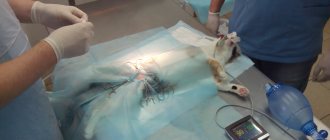With the onset of the warm season, the number of diseases caused by tick bites in cats increases sharply. With the onset of spring, pet owners begin to worry about how to protect their pet from this problem by any means. A tick bite in itself is not so terrible for a cat; dangerous pathogens are contained in the tick’s saliva, which can cause a number of dangerous and sometimes fatal diseases for a cat. Cats that walk through tall grass or dense bushes are especially at risk, where they are especially likely to pick up ticks. The tick that has just attached itself to the cat's skin is about the size of a pinhead. Over time, after he drinks blood, he grows to the size of a bean and is impossible not to notice.
General information about ticks. Ticks (Acarina) are small (0.1-30 mm) arthropods of the arachnid class (Arachnoidea) belonging to the largest group in the arthropod subclass, their number reaches 50 thousand species, most of which do not cause any harm to humans and animals. Ticks that parasitize cats are usually classified as carnivorous parasites, leading to the development of allergies, dermatitis, bacterial and viral diseases. Some ticks that attack cats drink blood, others chew the skin, and others feed on skin secretions and lymph. Cats are most often parasitized by three types of ticks:
Ixodidae (Ixodidae) are the largest ticks, which in a hungry state reach 2-3 mm in length, and after sucking blood - up to 1-1.5 cm. Scabies (internal, ear).
Subcutaneous (demodectic).
Mouth organs (piercing, gnawing, cutting, sucking). In all ticks they are formed by the first two pairs of limbs, chelicerae and pedipalgi; in ixodid ticks they consist of a pair of cutting chelicerae and a hypostome (an outgrowth of the lower edge of the mouth opening, covered with spines), tracheal or cutaneous respiration. Eyes are usually absent, less often there are 1-2 pairs. The stomach is saccular, in blood-sucking ticks with blind outgrowths that fill with blood during blood sucking. The excretory organs are represented by a pair of Malpighian vessels. Blood-sucking ticks have well-developed salivary glands, the secretion of which prevents blood clotting. All ticks are dioecious. The difference between females and males is well expressed, fertilization is internal. Most ticks are oviparous. The six-legged larva is the most characteristic feature of ticks.
The life of a tick can be roughly divided into four stages: egg, larva, nymph and adult. The total lifespan of a tick is about two months. After the tick drinks blood, it falls off and the larva begins to molt. Subsequently, the larva moves to the next stage of development, becoming a nymph; the nymph molts, turning into an adult tick, which is capable of leaving behind offspring. Ticks reproduce thanks to the female's ability to lay eggs. Considering that ticks that attack a cat multiply quickly and create optimal conditions for the development of bacteria and viruses, the owner should not delay treating the cat for ticks.
The process of a tick attacking a cat . Hungry ticks find their prey thanks to the presence of special thermal sensors. A cat passing by a bush or grass on which a tick is sitting becomes an object of attack; the tick makes a jump and, clinging to the hair, remains on the cat. Having latched onto a cat, the tick begins to look for a place on the body that is least covered with hair (skin around the ears, neck, legs, abdominal area, etc.). Further digging into the skin with its tentacles, the tick pierces the skin and begins the process of sucking blood. It becomes almost impossible to tear it away from the cat at this time, and only after the tick has completely drunk blood does it fall off the cat’s skin.
How does tick infection occur?
Exogenous parasites can live on land, in water, and on other animals. Therefore, the danger of infection exists every day. Even if your pet does not go outside for walks, you should not think that the cat is safe. How can a tick get on an animal? It's simple. You walked through the grass or past bushes, through a forest park or walked along an alley, and a small hungry tick got on your clothes. This is how you bring it home - on yourself.
Hungry ticks (photo below), especially if the peak of their activity has arrived, are very nimble.
They are also very small and are not afraid of anything. And only fire will stop the ixodid tick altogether.
Some people mistakenly believe that there is nothing dangerous about ticks sitting on a cat. However, it is not.
Firstly, the parasite can be a carrier of dangerous diseases.
Secondly, ticks in cats can get into the ears and under the skin, making the process of finding them extremely difficult. We must not forget that ticks can “spread” from a cat to other pets and even to people (ear mites are not dangerous for humans, but they happily “spread” to healthy cats).
Possible consequences of a bite
There is a myth that an Ixodid tick bite is safe for a cat, but this is only a misconception. Ticks can carry dangerous diseases:
- Hemobartonellosis. In another way, it is called infectious anemia, caused by Bartonella (a type of microorganism).
- Borreliosis or Lyme disease. The waste products of the Borrelia pathogen cause a severe allergic reaction in the pet, muscle and heart pain, kidney and brain damage.
- Theileriosis. The cat's lungs, kidneys, heart, and liver suffer. This disease is difficult to treat.
During the time taken measures are ways to prevent difficult health situations in the future.
Piroplasmosis
This disease is an intracellular parasite that is transmitted by ticks. Oxygen starvation occurs and the mucous membranes are damaged. The body loses the ability to process hemoglobin. This is how direct bilirubin appears - a toxin that gradually poisons the entire body. The animal can die within 4 days after the bite.
Encephalitis
This is an inflammation of the animal's brain, as a result of which the central nervous system dies. Humans are also susceptible to this disease. For an animal, encephalitis is deadly. Ticks are carriers of encephalitis, including one that is dangerous to humans.
When you urgently need to see a veterinarian
You should contact your veterinarian as soon as you notice changes in your cat’s behavior or a deterioration in its health. Do not forget that after the tick has been removed, it must be sent for appropriate tests.
Ear mites in cats
A pet can become infected with ear mites as a result of:
- communication with a sick animal;
- contact with contaminated objects, which may include dishes, hygiene items, and bed mats.
In addition, there is a high probability that ear mites could be brought into the house from the street by any family member. You can also “grab” a tick with you at the entrance, where stray infected cats often end up. Insects, parasites that often infect animals, also become carriers of ticks. A person need not be afraid of infection - contact with a sick cat is not dangerous for him.
Folk remedies
It is recommended to use in cases where it is not possible to purchase a special drug. Folk remedies are not highly effective; they dry out the skin and cause allergies.
- Lather the cat with soap containing birch tar. Wrap it in cling film, and after 5-10 minutes bathe the animal. Repeat the procedure several times with a break of 2-3 days.
- Areas of skin with fallen hair are lubricated with kerosene. After 3 days the pet is bathed. If necessary, repeat the treatment again.
- To speed up the restoration of the epidermis, use calendula tincture and chamomile decoction. Wipe 2-3 times a day.
If there is no therapeutic effect within 7 days, you need to show the cat to a veterinarian. If an allergy appears against the background of alternative treatment, stop treatment immediately.
Ear mites in cats - symptoms
Under the influence of the disease, the behavior and physical condition of the animal changes. The following signs indicate that a cat is infected with ear mites:
- The pet behaves restlessly, constantly “shaking” its head, meowing often, clinging to the owner, tilting its head to the side.
- To relieve the unbearable itching, the animal rubs its ears against the corners of furniture and various objects, often scratching them.
- After some time, a purulent mass may emerge from the auricle.
- The cat develops brown crusts inside and around the ear.
If untreated, tick symptoms in cats worsen, and the inflammation gradually affects the inner and middle ear, moving further to the meninges. This condition is indicated by such signs of ear mites in cats as:
- depressed state;
- increased body temperature;
- head curved towards the affected ear;
- seizures leading to the death of the animal.
You can prevent terrible consequences if, when the first symptoms of otodectosis appear in cats, you contact a veterinarian to prescribe treatment.
A cat has ear mites - treatment
Treatment of ear mites in cats cannot be undertaken without an accurate diagnosis, since symptoms similar to this infection are present in other diseases. The doctor will be able to check whether your suspicions regarding this disease are justified when he examines the animal’s ears using special instruments and, if necessary, conducts a microscopic examination of the ear discharge. After otodectosis is confirmed, the specialist will prescribe and carry out treatment procedures:
- First, the ears will be cleaned by rinsing with antiseptic agents.
- Then liquid medications are instilled using a syringe with a rubber tube (usually ear mite drops for cats, which, according to the instructions, are injected into both ears of the animal, even when only one is inflamed). In this case, it is necessary to adhere to the exact dosage of the drug, because it contains a strong poison, which in a large dose can aggravate the pet’s condition.
- After the treatment procedure, you should massage the base of the cat’s ear.
Ixodid ticks
These insects often live in forested areas: on trees and shrubs. But it is possible that ixodid ticks live on grass and ground. Even if the forest is far away, the tick may end up in a desert area. For example, the wind brought a leaf or blade of grass on which the parasite was sitting.
Once the tick attaches, your cat or you become the victim. The parasite firmly attaches to the skin and begins to burrow into the skin. His head is inside the tissues, and his body is outside. And when it starts sucking blood, it increases tenfold!
Even if there is no pathogen inside the tick, the harm to health is considerable. Firstly, the tick secretes a secretion at the site of the “bite” that causes severe inflammation and itching. The animal will begin to itch, worry, and may pick off the sucking parasite with its paw. The bloodsucker's jaws will remain closed inside the skin, so even if it is torn off, its head will remain in the animal. This often leads to suppuration, and sometimes sepsis occurs.
What is demodicosis
Subcutaneous mites under a microscope
Demodicosis in cats is caused by 2 types of microscopic mites: Demodex cati and Demodex gatoi. The first lives in hair follicles and adjacent tissues, the second - in the superficial layers of the skin. The size of the parasites does not exceed 0.5 mm; they can only be seen under microscope magnification. The transparent body is supported on legs with hooks, the oral cavity looks like a proboscis. This parasitic disease affects the cat's skin and hair.
Demodex develops in the body of one carrier and dies in the external environment after 2 hours. An adult gnaws through the epidermis, penetrates the hair follicle, where it feeds on cell breakdown products, sebum and reproduces.
From the egg to the mature individual, the tick passes through the stages of larva, protonymph and deutonymph. The parasite develops in both active and passive forms: in the first it feeds and grows, in the second it becomes motionless. The biological cycle lasts 20–25 days; in 3 months, at least 3 generations of mites develop in the cat’s body.
How to properly remove a tick from a cat?
It is extremely important to properly remove a tick from a cat. Ideally, you need to arm yourself with special tweezers, because you can crush the reptile with tweezers.
Grab the tick at the neck and gently turn it counterclockwise until it opens its jaws and falls off. No oils, creams or hot needles in the torso! Yes, sometimes this leads to the parasite unclenching its jaws, but more often it, on the contrary, closes them even more tightly and then dies. And only then can it be removed surgically.
Do not pull, tear, tug, wrap with thread, handle with bare hands, or use tweezers.
There are many prohibitions, but in reality everything is not so complicated. If you suspect that you cannot cope on your own, then seek help from a veterinarian. He knows how to properly remove ticks (photo) from cats.
Don't throw away the ticks! They are very tenacious. Collect them in a glass bottle (for example, left over from penicillin or some other drugs, a jar of baby food will do).
Ideally, you should take the extracted parasite to the center of sanitation and epidemiology or to a veterinary laboratory so that it can be studied. If the causative agent of piroplasmosis is found in it (and this is also a parasite that “settles” in red blood cells, destroying them), then it is necessary to begin treatment of the cat affected by the tick as soon as possible. In addition to piroplasmosis, a tick can “give” your pet diseases such as theileriosis, tularemia or hemobartonellosis.
Subcutaneous mites in cats
The subcutaneous mite often affects dogs, but cats also suffer from this parasite. This reptile is called Demodex.
It is worth noting that a person can also become infected with demodicosis through contact with a sick animal! Alopecia, acne, and inflamed red areas appear on the skin. The cat itches, “cries”, worries. Therefore, it is necessary to be extremely careful in “communicating” with stray or “suspicious-looking” animals.
Try not to let your pet go for a walk alone, do not let him “get acquainted” with other animals so that your cat does not become infected.
The incubation period of demodicosis can last for years!
But as soon as the cat’s immunity weakens, this parasite will make itself felt. Most often, these mites (photo) in cats affect the areas around the eyes, ears, and neck. The hair falls out, severe itching begins, the skin turns red and becomes inflamed. It is very difficult to cure a cat from these mites.
In addition to demodicosis, notoedrosis may occur - this disease is caused by scabies mites, which are also localized under the skin. Of course, the symptoms will be similar to the clinical signs of scabies:
- itching;
- hair loss;
- anxiety.
You should be extremely careful, it is better to contact your veterinarian for help.
Treating cats for ticks at home
Many owners wonder how to treat a tick on a cat at home, but a competent veterinarian will answer that it is not the tick that needs to be treated, but the animal itself. The main thing is not to resort to self-medication and be patient. It is already clear that depending on the type of tick and other circumstances, the parasite can infect your cat. And it is obvious that it is impossible to treat such diseases at home. In the case of subcutaneous parasites, even specialized treatment of a cat for ticks can take more than one month or even a year. And follow safety precautions so as not to suffer from the parasite yourself.
Kinds
Most often, the animal is affected by a microorganism called demodex. It cannot be seen without a microscope. It is shaped like a worm.
Demodicosis occurs in two varieties:
- localized;
- generalized.
With a localized form, a certain part of the skin is affected. In the case of a generalized form, the entire body is affected.
In this situation, after treatment, the cat should undergo a sterilization procedure, since the microorganism can be transmitted to offspring.
Anti-tick drops for cats
Medicine in the form of drops is very common, as it is one of the safest and most affordable. It is used not only to combat infection, but also to prevent otodectosis.
The course of treatment begins with the use of an emulsion, the fundamental component of which is Fipronil, Fenthion or Permethrin. The product must be rubbed into the skin of the withers and make sure that the animal cannot lick it off until it is completely absorbed.
To treat ear mites in cats, the following brands of drops are usually used:
- Celandine (the active ingredients of the drug are Fipronil and Permethrin).
- Biafar (differs from other drops by the presence of a natural component based on margose, which destroys insects).
- Leopard (the main component is Permethrin) is low toxic for cats, which explains its popularity.
- Frontline (the active ingredient of the drug is Fipronil) is effective against ear mites and their carriers, fleas.
Anti-tick collar for cats
But not only drops have the same effect on ticks and fleas: the most popular is a special collar against parasites. And this is explained by its undeniable advantages:
- simplicity and ease of use;
- safety for the cat;
- efficiency of application.
A high-quality flea and tick collar for cats is the best choice for the treatment and prevention of otodecosis. When choosing a product, pay attention to its characteristics:
- A quality product is always sealed in a foil bag.
- The collar should be intended only for cats (also separately for kittens and for pregnant or lactating pets).
- The material should not contain: Permethrin, Amitraz and organic phosphates.
Prevention
There is no vaccination against ticks! The salvation will be the special collars described above, drops on the withers. Ideally, you should refrain from walking through the forested area during the period of greatest tick activity (April-June, August-October). If there are disadvantaged places in your city, then do not go near them.
Before letting your pet into the house, carefully comb out the entire skin with a fine comb, inspect the belly, chest, paws, and ears. If you have combed out ticks, do not leave them on your doorstep. Otherwise they will stick to someone. On shoes or clothes they will enter someone's home (and maybe yours again).
To prevent your pet from getting ticks, try to avoid contact with other animals. At the slightest suspicion of infection, contact your veterinarian. He will take skin scrapings from the affected areas (in the case of subcutaneous mites) or take a whole skin parasite for examination. Only after a final diagnosis has been made, treatment will be prescribed.
Animal risk group
Parasitic arachnids affect all predators, regardless of breed, sex, or age. A healthy pet with a strong immune system is not in danger. Under such conditions, the animal and arthropods are in an antagonistic relationship, where the cat’s body slows down the growth of parasitic microorganisms.
The following groups are susceptible to demodicosis:
- young individuals, especially those separated from their mother early;
- affected by leukemia and immunodeficiency viruses;
- with diagnosed immunosuppressive diseases (diabetes mellitus, toxoplasmosis);
- animals in the postoperative period;
- young offspring during the period of change of milk teeth to molars (4-6 months);
- exhausted after fasting;
- patients with rickets.
Stress caused by moving and frequent visits to the groomer negatively affects the health of the pet. The risk of ascariasis increases.











